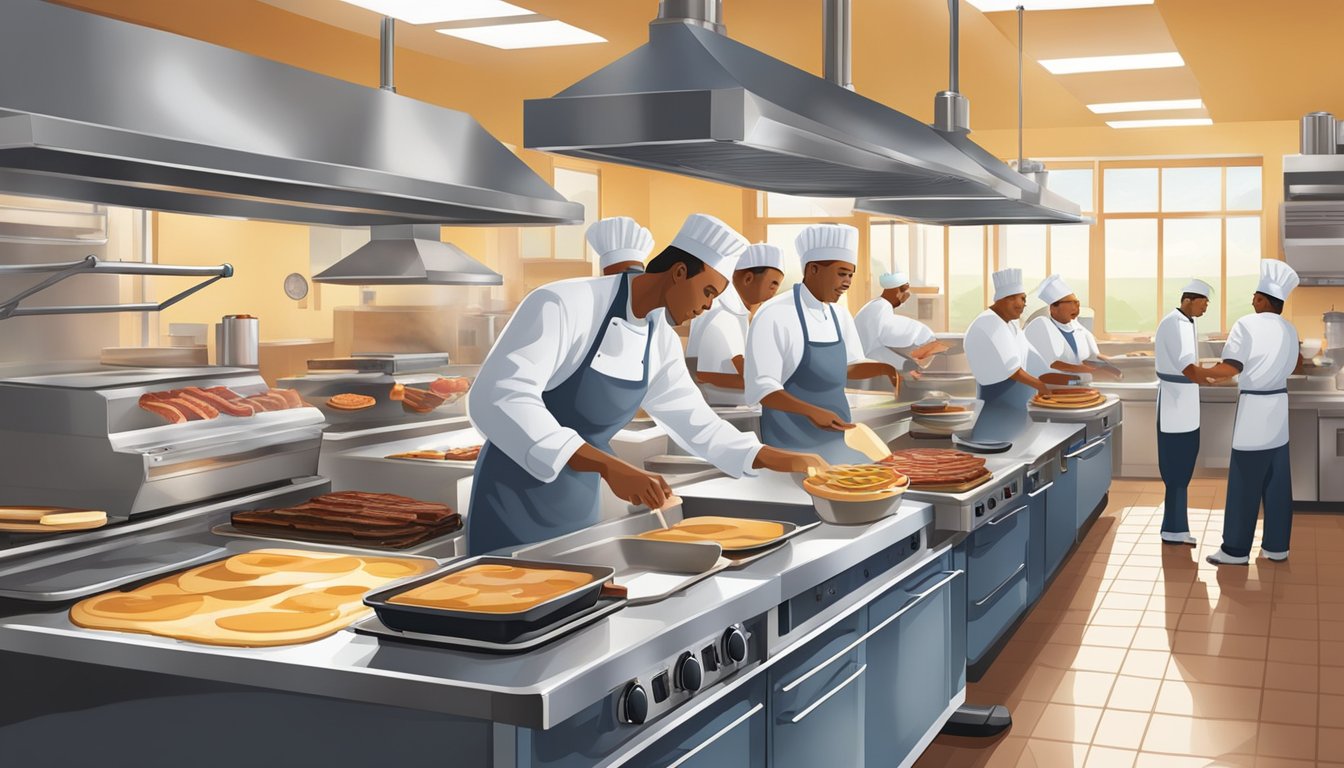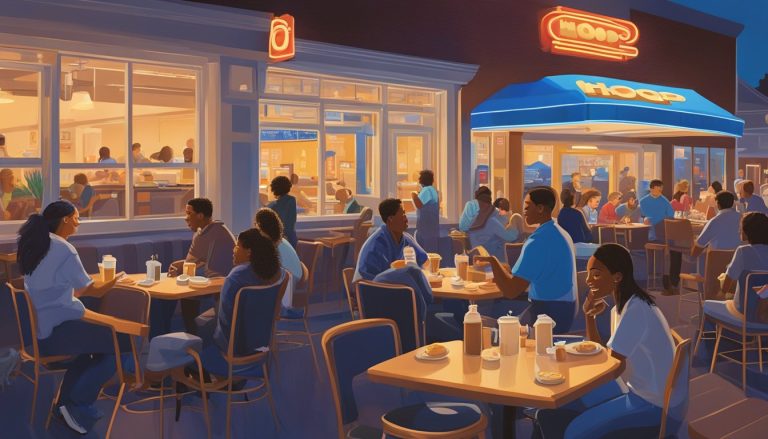The bustling kitchens of IHOP restaurants across the country come to life long before most customers even think about breakfast. As the sun rises, skilled chefs begin their daily routines, preparing for the breakfast rush that will soon flood the dining room. IHOP chefs typically start their workday around 5 AM, facing a fast-paced environment where they must efficiently cook hundreds of meals in a short time frame.
These culinary professionals juggle multiple tasks simultaneously, from cracking countless eggs to flipping stacks of pancakes. They meticulously follow standardized recipes to ensure consistency across all IHOP locations while maintaining the quality customers expect. The kitchen atmosphere is charged with energy as orders stream in and chefs work in perfect synchronization to meet demand.
Throughout their shift, IHOP chefs face challenges such as managing inventory, maintaining food safety standards, and collaborating with servers to ensure timely order delivery. Despite the hectic nature of their work, many find it rewarding to create delicious meals that bring joy to diners. The role requires not only culinary expertise but also stamina, quick thinking, and excellent teamwork skills.
A Day in the Life Overview
An IHOP chef’s day is filled with careful preparation, precise timing, and a commitment to quality. Their role involves orchestrating the kitchen’s operations to ensure a smooth dining experience for customers.
Starting the Day
IHOP chefs typically arrive early, often before sunrise. They begin by reviewing the day’s reservations and anticipated customer volume. This information guides their menu planning and ingredient preparation.
The chef then checks inventory levels, noting any shortages or items nearing expiration. They may place orders for fresh supplies if needed.
Next, they inspect the kitchen equipment, ensuring all appliances are clean and functioning properly. This step is crucial for maintaining food safety standards and efficient service.
Prepping Ingredients
With the kitchen ready, the chef focuses on ingredient preparation. They oversee the chopping of vegetables, mixing of batters, and portioning of meats.
Quality control is a top priority during this phase. The chef tastes sauces, checks the consistency of batters, and ensures all ingredients meet IHOP’s standards.
Prepping also includes setting up mise en place stations for each cooking area. This organization allows for quick and efficient meal preparation during busy service hours.
Setting Up the Kitchen
As the opening time approaches, the chef briefs the kitchen staff on the day’s specials and any changes to the menu. They assign roles and responsibilities to each team member.
The chef then conducts a final walk-through of the kitchen, checking that all stations are properly stocked and organized. They ensure safety protocols are in place and that the kitchen is ready to handle the day’s orders.
Lastly, they coordinate with the front-of-house staff to align kitchen operations with dining room expectations. This collaboration helps maintain a smooth flow of service throughout the day.
Menu Execution and Custom Orders
IHOP chefs balance standardized menu items with personalized customer requests. They follow strict corporate guidelines while adapting to individual preferences and dietary needs.
Following IHOP Standards
IHOP chefs meticulously adhere to corporate recipes and procedures. They prepare batters, syrups, and toppings according to precise specifications. Portion control is crucial, with chefs using standardized scoops and measuring tools.
Cooking times and temperatures are carefully monitored to ensure consistency. Chefs use specialized griddles and waffle irons calibrated to IHOP standards. Plating follows strict guidelines, with each item arranged in a specific manner.
Quality control checks are performed regularly. Chefs taste-test batches of pancake batter and syrups to maintain flavor consistency. They also inspect ingredients for freshness and proper storage.
Adapting to Customer Preferences
IHOP chefs skillfully accommodate special requests and dietary restrictions. They modify recipes to create gluten-free, dairy-free, or vegan options when possible. Allergen awareness is paramount, with chefs using separate utensils and cooking surfaces to prevent cross-contamination.
Custom orders are carefully executed to meet customer expectations. Chefs adjust cooking times for eggs prepared “over easy” or “well done.” They incorporate additional ingredients like fresh fruit or chocolate chips into pancakes upon request.
Seasonal promotions and limited-time offers require flexibility. Chefs quickly learn new recipes and techniques to execute these special menu items. They balance efficiency with attention to detail, ensuring both standard and custom orders are prepared to IHOP’s high standards.
Peak Hours Management
IHOP chefs expertly navigate intense periods of high customer demand. They leverage culinary expertise and efficient systems to maintain quality while handling large order volumes quickly.
The Breakfast Rush
IHOP’s breakfast rush typically occurs between 7-10 AM. Chefs arrive early to prep ingredients and equipment. They organize stations for maximum efficiency, ensuring easy access to common items like eggs, pancake batter, and bacon.
During peak times, chefs multitask seamlessly. They may simultaneously cook eggs, flip pancakes, and assemble plates. Communication with servers is crucial to prioritize orders and manage ticket times.
Chefs use specialized equipment like large griddles to cook multiple items at once. They rely on muscle memory and practiced techniques to work quickly without sacrificing quality.
The Lunch Rush
The lunch rush usually hits between 11:30 AM and 1:30 PM. Chefs transition from breakfast to lunch items, prepping salads, sandwiches, and burgers.
They adjust cooking temperatures and techniques for lunch dishes. Grills are fired up for burgers and steaks, while fryers handle increased demand for fries and appetizers.
Chefs coordinate with expeditors to ensure proper plating and garnishing. They maintain a steady pace, balancing speed with attention to detail on each dish.
Maintaining Quality and Speed
Chefs use several strategies to uphold IHOP’s standards during busy periods:
- Pre-portioning ingredients to speed up assembly
- Utilizing par-cooked items for faster finish times
- Implementing station rotation to prevent burnout
Quality checks are performed regularly. Chefs taste sauces, check food temperatures, and inspect plating before dishes leave the kitchen.
They also manage inventory during rushes, communicating with staff to restock depleted items quickly. This proactive approach helps maintain consistent service throughout peak hours.
Culinary Expertise in Action

IHOP chefs showcase their culinary prowess through creative daily specials and perfectly executed breakfast classics. Their expertise shines in crafting exceptional meals that keep customers coming back.
Creativity in Daily Specials
IHOP chefs flex their culinary muscles by developing unique daily specials. They experiment with seasonal ingredients and flavor combinations to create enticing new dishes. These specials often incorporate trendy food items or cater to dietary preferences like gluten-free or plant-based options.
Chefs collaborate with management to ensure specials align with customer preferences and ingredient availability. They meticulously test and refine each recipe before adding it to the menu. This process allows IHOP to offer fresh, exciting options alongside their traditional favorites.
Special promotions, such as holiday-themed meals or limited-time offers, further showcase the chefs’ creativity. These dishes often become highly anticipated events for regular customers.
Perfecting Pancakes and Omelets
IHOP chefs excel at preparing the restaurant’s signature items – pancakes and omelets. They master the art of achieving the perfect pancake consistency: light, fluffy, and golden-brown. Chefs carefully measure ingredients and monitor cooking temperatures to ensure consistent quality.
For omelets, chefs demonstrate their expertise in proper egg cooking techniques. They skillfully fold in various ingredients, creating visually appealing and flavorful combinations. Timing is crucial, as chefs must deliver omelets that are fully cooked yet still moist and tender.
Chefs also focus on plating presentation, arranging each dish to maximize visual appeal. They pay attention to details like symmetry, color contrast, and garnish placement. This attention to detail elevates the dining experience and reflects the chef’s culinary expertise.
Behind-the-Scenes Operations
IHOP chefs manage complex operations to ensure smooth kitchen functioning. They handle inventory, collaborate with staff, and maintain quality standards throughout their shifts.
Inventory Management
IHOP chefs start their day by checking ingredient stock levels. They assess perishables like eggs, milk, and produce, ensuring adequate supplies for anticipated customer volume. Chefs place orders for depleted items, coordinating with suppliers for timely deliveries.
Proper storage is crucial. Chefs organize walk-in refrigerators and dry storage areas, rotating stock to maintain freshness. They label and date items, adhering to food safety regulations.
Chefs also monitor equipment inventory. They ensure sufficient cooking utensils, plates, and smallwares are available. When necessary, they request replacements or repairs for faulty kitchen equipment.
Collaboration with Staff
Effective communication is vital in IHOP kitchens. Chefs brief line cooks on daily specials and menu changes. They assign tasks, ensuring each station is properly staffed.
During service, chefs oversee food preparation, guiding less experienced staff. They step in to assist during rush periods, maintaining efficiency and food quality.
Chefs also work closely with servers. They address questions about menu items and accommodate special dietary requests. This collaboration ensures accurate order fulfillment and customer satisfaction.
Quality control is a key focus. Chefs regularly taste-test dishes, ensuring consistency in flavor and presentation. They provide feedback to staff, promoting continuous improvement in food preparation techniques.
Ending the Day

As the final customers depart, IHOP chefs transition to closing tasks. Their focus shifts to cleaning, restocking, and preparing for the next day’s service.
Cleaning and Closing Procedures
Chefs begin by thoroughly cleaning kitchen equipment and surfaces. Grills, fryers, and prep stations are scrubbed and sanitized. Utensils and cookware are washed, dried, and properly stored.
Floor cleaning follows, with sweeping and mopping to ensure a hygienic environment. Trash is removed, and new liners are placed in bins.
Chefs check refrigerators and freezers, discarding any expired items. They organize remaining ingredients and ensure proper storage temperatures are maintained.
Finally, they conduct a last walk-through of the kitchen, double-checking that all appliances are turned off and safety protocols are followed.
Preparation for the Next Day
Chefs review inventory levels and restock essential ingredients. They prepare batters, sauces, and other items that can be made ahead of time to streamline morning service.
Menu planning occurs, with chefs discussing any specials or promotions for the following day. They coordinate with managers to ensure adequate staffing and supplies.
Prep lists are created, detailing tasks for the morning crew. This includes thawing frozen items, cutting fruits and vegetables, and portioning ingredients.
Equipment maintenance is addressed, with any issues reported to management for prompt resolution. Chefs also set up workstations for efficient morning operations.




